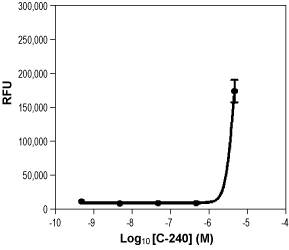Overview
- De Petrocellis, L. et al. (2001) Br. J. Pharmacol. 163, 1479.
- De Petrocellis, L. et al. (2001) Br. J. Pharmacol. 163, 1479.
- Romano, B. et al. (2013) Br. J. Pharmacol. 169, 213.
- Russo, E.B. (2011) Br. J. Pharmacol. 163, 1344.
Cannabichromene (CBC) is a member of the cannabinoids, compounds derived from a diterpene structure origin of the marijuana plant Cannabis sativa, and particularly abundant in freshly harvested dry-type Cannabis material. These compounds have been used for over a 1000 years as medicinal agents for the relief of pain, as well as for recreational purposes1.
CBC is a major non-psychotropic phytocannabinoid that inhibits endocannabinoid inactivation and activates the transient receptor potential ankyrin-1 (TRPA1) channels and enzymes of the endocannabinoid system. In addition, it also acts as a TRPM8 antagonist.
CBC selectively reduces inflammation-induced hypermotility in vivo independently from cannabinoid receptors or TRPA11,2.
Several studies have demonstrated that CBC exerts antimicrobial, anti-inflammatory, analgesic and antidepressant-like activity in rodents and has the ability to normalize in vivo intestinal motility in an experimental model of intestinal inflammation3.
Cannabichromene potency tested induced TRPA1-mediated Ca2+ elevation showed efficacy of EC50 of 90 nM1.
Cannabichromene (#C-315) is a highly pure, synthetic, and biologically active compound.


